|
Digital art slash photography - originally published on PhotographyMatters.com, April 2008. In 1998, ten years ago to the month, I purchased an off-the-shelf computer and Photoshop 4.0. Prior to that, if you wanted to do anything much with digital photography it was an expensive exercise, more the realm of professionals. Also at that time, for around a grand you could buy an amateur digital camera with about a megapixel of image resolution; useful for postcard-size prints. So let’s call this the tenth anniversary of digital photography for the masses. Surprising, then, how relatively little serious art has been made using digital cameras and Photoshop in the last ten years. I’m talking about going beyond what was possible pre-digital; sure, anyone can take a picture and muck around with the various filters, a thing we’ve all done for fun. (The pre-digital equivalent was Cokin effects filters, something real photographers would never resort to.) But how often have you seen really interesting photography that utilises the possibility and control these now ubiquitous tools offer? I recall one show at the Sarjeant Gallery, Wanganui, by Anthony Goicolea (thanks Microphen). He photographed himself to create casts of dozens in metres-long tableaux, to great effect. At Photospace gallery, I have shown Siren Deluxe’s A Gender series; male and female nudes skilfully blended into hermaphrodites, photographed in domestic interiors; also Yvonne Westra’s Staged; black & white pigment prints of multiple photographs crafted into surrealistic, dreamlike scenarios. Steven McNichol’s Joel-Peter Witkin-inspired horrors used Photoshop to blend layers of man and beast, extending the subtlety and possibilities of his already considerable darkroom technique. Two exhibitions in Wellington, one by Grant Sheehan at Bowen Galleries and the other by Brian Fernandes at Thistle Hall Gallery, feature works that began their lives as photographs of things or people and ended up as something quite different. In viewing both of these exhibitions, I asked myself the same question: why even start out with a photograph? In Grant Sheehan’s case, it seems natural. We know his photographs from numerous published books, most of which explore and record architecture and the urban landscape. Think cafés of NZ and the world, Wellington by evening light, historic lighthouses, etc. (And he has just won Cathay Pacific Travel Photographer of the Year – congratulations Grant.) So, after several decades of straight photography, I applaud him for moving out of his comfort zone and creating something completely different and unexpected. The digital images, printed to a medium size on metallic photo paper and pinned to the gallery wall, look like a trip back into 70s psychedelia. I can imagine Sheehan spending long hours glued to his computer with Hendrix, Cream and The Doors coming off vinyl at high volume for inspiration. I’m sure that if you spend the time looking into these artworks you’ll see all kinds of stuff, (like in the Camel cigarette packet illustration) but they’re not for me, personally. While Sheehan used Photoshop’s facility for building and blending multiple image layers, Canadian artist Brian Fernandes used a computer algorithm of his own design. His digital artworks have titles like Thinking Man and Man and woman reclining; and one wonders how the images, which look like glowing spheres hovering in deep, black space, were ever human figures. Someone asked me, ‘What is it, a close-up of a nipple?’ In fact, the various coloured pixels that once formed a completely coherent image of a nude man, woman or couple photographed against a black background, were systematically rearranged according to the artist’s mathematical formula, number-crunched into something else entirely; the said floating sphere-like form. And they are beautiful things. After seeing the works at Thistle Hall, I asked Brian if he’d like to show them at Photospace for a while, so the four large pieces are now hanging in the studio lounge area. Come and have a gander, see what you think. (Brian’s statement about his process, I posted here.) You’re waiting for me to ask this question, yes: is it photography? Well, I’m not asking it. (No, I just did, didn’t I.) What I mean is I’m not that interested in the answer. Does it matter what they are? Does it matter whether the viewer can visually perceive the photographic origin of the images? Do we need to categorise? I guess that if there wasn’t a photograph in there somewhere, then I wouldn’t be blogging about the things. You can create your own pixels in a few keystrokes, but you need some variation, some texture or line or shape to get a hold of before you can really start to play about. You need some origin. A photograph of something—anything—is an easy place to start from. You don’t even need to take your own. Brian Fernandes looks to have gone to some trouble to take his nudes, thus gaining true ownership of the images and their titles, but he could’ve just as easily started from a downloaded snap of Paris Hilton. What Grant Sheehan’s images started off as, only he knows. A café? A lighthouse? I’m still figuring this out, thinking as I write, (you can tell?), and I guess I’m neutral here. Every image we see is manipulated to some degree; by the mind and attitude of its author, editor, or the political stance of the publication or context in which it appears; and particularly these days because, at some stage before we see it, it’ll be a bunch of pixels on some person’s computer screen. So why not go the full monty and take that manipulation to the nth degree, make something that is unrecognisable as its original form? OK, so it’s not photography. So what? Sorry it’s been a while since my last rant. I was busy getting married and stuff. by james | 21 April, 2008 Comments below.
0 Comments
Photography as Public Art; the Courtenay Place Park inaugural light box photo exhibition, Flanerie and figments - published in PhotographyMatters.com in May, 2008 The precedent for this exhibition was at Waitangi Park on the Wellington waterfront when it opened in 2005. Tens of thousands enjoyed the outdoor exhibition of photographs by Yaan Arthus-Bertrand. Overhead shots of flocks of birds, herds of hippos or whatever seemed to conform to most peoples’ idea of exciting photography. (I guess these are the same people who flock to the international press photography award shows for similar reasons.) Risking sounding like a snob, the nature images bored me rigid. (This is possibly a result of excessive exposure to nature docos on telly in the 90s.) The photos in the light boxes outside the St James Theatre, Courtenay Place, Wellington have the opposite effect on me: they are very engaging. There have been a number of proposals for the remodelling of this area over the last decade or so, but at last it has been done (except the old toilets…). This inaugural exhibition, Flanerie and figments, was curated by Andy Palmer, working with the park’s designer Simon Bush-King. Andy told me the photo selection was an 18 month project, requiring the approval of the Public Arts Panel. As Wellington mayor Kerry Prendergast said in her speech at the park opening last Friday evening, 2nd May, some of the images were not to her taste. And I have to say, as exhibition openings go, this was a goodie; very nice wine and food, a jazz band, no bouncers on the door or the kind of heavy-handedness experienced at City Gallery openings, (where one can feel like a schoolkid being herded around, forced to listen to interminable speeches by numerous sponsors before being allowed to touch the wine, etc (I can feel myself being plucked from the invitation list…)), and the speeches were kept concise. I would like to congratulate the Wellington City Council for their part in this project; for agreeing to put large scale photographs in the middle of town where thousands will see them daily, and for not butting in and censoring the images, even though they have expressed a level of disapproval. Public art should be controversial. No, it would’ve been much easier for the WCC to push for “professional” photographs, highlighting or celebrating some absolutely positive aspect of the city, perhaps making people feel more optimistic about the place, but being ultimately banal. Glad they saw sense and let the curator and designer do their work. Funnily enough, I was the only person at the opening with a proper camera (with the intention only of taking the images for this blog). There was no press photographer there, and no appointed WCC photographer that I could see. Could it be that with the possible controversy surrounding these selected images, the attention of the press was not sought? Normally an event like this would receive coverage, I would’ve thought. http://www.wellington.govt.nz/news/display-item.php?id=3198 for more info about Courtenay Place Park. 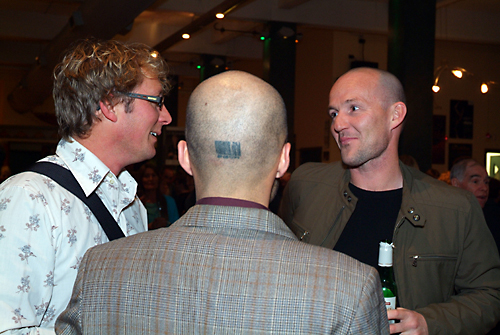 Curator/artist Andy Palmer, artists John Lake and Shaun Lawson, at the opening. As I said before, I find the work (mostly) engaging. It’s the sort of material you would see in a small, edgy gallery where it would then only find a few hundred viewers. Here, anyone passing on a bus gets a good view of at least eight of the sixteen 3m high images. And a healthy proportion of pedestrians are stopping to explore. As a bunch of photographs, these certainly challenge the viewer. My favourite is John Lake’s photo of a girl standing in a tree; one of those images that asks more questions than it answers. Palmer’s pale treescapes, panoramas disconcertingly rotated and set vertically, seem to predict the aging effects the other images may suffer in their six-month tenure. Shaun Lawson has set out to be controversial, with the box at the Mt Victoria end of the park housing his image of a grossly extended tongue; one of the photos that didn’t appeal to the mayor. His other image, from his Actress series, shows a young woman who has suffered a beating from her partner. (This image may soon be withdrawn and replaced by another in the same series.) I particularly enjoy Steve Rowe’s larger than life photos of money machines. At this totemic scale, they are at once deceptively real (I wonder how many people will bowl up in their cars to use them, or maybe try to tow them out) and objects of worship to the stuff that increasingly drives our society. Courtenay Place is the perfect location for them. Clare Noonan’s almost featureless coastal landscapes have a walk-in feel, and are confrontational in their abandonment of traditional, camera club-type compositional elements. I’m a fan. Amelia Handscomb’s images of the historic Thorndon house The Moorings (as photographed by Robin Morrison in the mid 1970s) gain in tension from being sited in the urban pastiche that in Courtenay Place, 2008. The architecture of the Reading Theatre opposite, with its neon signage, is a particular contrast. Others will find the images by Jessica Silk (a nude, via Gustav Klimt, no less) and Victoria Birkinshaw (a boxer) fascinating. The photographs are somewhat eclectic, but are all by photographers in their twenties or thirties, none of whom appear in the recent book Contemporary New Zealand Photographers; that is to say, this lot are not the usual suspects, but the up and comers, the real contemporary photographers. While, apparently, a few teething problems have arisen, getting things to look perfect first time round at this scale, backlit and in the open, and dealing with the elements—it pissed down for the unveiling—would be near impossible. The technical issues are now known and will be resolved, and the minor flaws do not affect my enjoyment of these images. I look forward to future exhibitions of photography in this great new venue. Go the Creative Capital. by james | 8 May, 2008 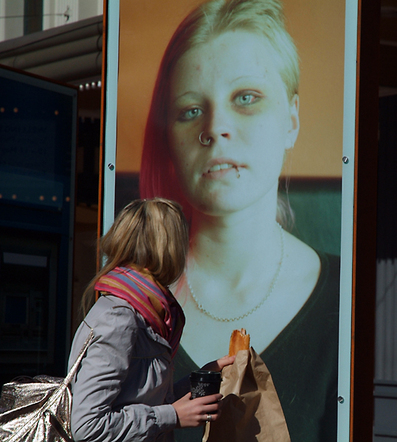 Viewing a photograph by Shaun Lawson - photo: Dominika Zielinska This photo by Shaun Lawson was later removed from the exhibition. Shaun's other photo was of a bovine tongue coming through a hole in something. Both images were chosen to challenge and perhaps perturb the viewer. It had that effect on our mayor. 7 Responses to “Photography as Public Art; the Courtenay Place Park inaugural light box photo exhibition, Flanerie and figments”
(I have removed the links below as they are mostly no longer not live.)
Back from the Wilderness - originally posted in PhotographyMatters.com, February 2009. My apologies for not posting to this blogsite for a time. And I guess the last couple of postings were a little lame, judging by the lack of comments. My excuse is I have been preoccupied with Paranormal Investigation lately. You may have seen the coverage in the Herald’s Canvas magazine supplement, among other things in the press, and I’ve been diddling with the website (using old-school html, version 0.5 or something) www.strange-occurrences.com The other reason for the lack of postings is that, frankly, things in the photography world have been a little dull lately. Nothing has got me fired up. OK, there are great new products around, but there are plenty of other forums and websites about the latest technological offerings and their pros and cons. No, I just haven’t found anything to get my teeth into. Having said that, I’m still a little steamed at the demise of the NZCP. Their collection of photographs and other photography-related items is in the process of being deacquisitioned; that is, being picked over by others. It’s probably for the best, because although the collection is being broken up, its better part will be rehoused in public collections with storage facilities and public and internet access that are better than the NZCP ever had. What continues to irk me is that all this has been done behind closed doors; there has been no information circulated by the board of trustees to the subscribership of the NZCP, many of whom have been long-term financial supporters and some of whom have even donated valuable items to said collection. What a shambles! So I am now going to resort to reviewing an exhibition currently showing in a gallery I own and half-run (not Photospace). It’s an installation that, among other things, seems to be about photography. It’s only on till March 3rd, so not many people will get to see it. And some of those who have seem completely mystified, walking out wondering if it’s an exhibition at all and not just something halfway through being installed. The review follows in the next posting - maybe tonight (but there’s some good telly on) or maybe tomorrow. [See below] Current recommendation: Peter McLeavey is showing an exhibiton of photographs by Laurence Aberhart. Although being a long-time fan, I have sometimes found Aberhart’s photographic approach a little dry. However, McLeavey’s selections of his work are always enjoyable and lively, and this exhibition perhaps shows a loosening of approach, a more humanistic view. I wonder if there has been a little reverse-influence on the master by the acolyte (you know who I mean). I only saw the work during the opening and so will have to revisit when the gallery is quieter. P.O.A. Collective Installation at GMG
The P.O.A. Collective are: F. Emera, R. Chival, Sue Denholm. Soundtrack by Wellington Analogue Noise Kollective. The installation “Divided by Zero” is at Gilberd Marriott Gallery, 37 Courtenay Place, Wellington, until March 3rd, 2009. www.gilberdmarriottgallery.com for gallery info, and http://www.photospace.co.nz/_gmg_pages/poa/POA-installation_photos.htm for installation photos. I have lifted a few of them for this review. I understand the title of the exhibition is drawn from its soundtrack. Mathematicians know that dividing by zero is more than an error; it makes no sense whatsoever. So when you place an antique Hewlett Packard calculator atop a detuned radio and instruct it to divide by zero (zero, enter, divide in Reverse Polish Notation) it gives an error signal, a flashing zero, which interferes with the radio signal in an annoying, obtrusive rhythm. Fuzzed out, this forms the background of the first half of the ambient soundtrack. Other devices employed, I am told, include lowering the recording device (ironically, a digital voice recorder) into a cannon shell (”Shellcase”) and raising it out again. These guys sound like performance artists. I for one would be intrigued to see a performance by W.A.N.K. in the gallery installation, but it has proved impossible to arrange. The installation itself is somewhat hard to pin down, as it seems to be concerned with two seperate issues: the demise of conventional photographic practise and the sacrosanct but temporary nature of the exhibition space itself, in general. Let’s deal with the latter aspect first. The blue screen (actually a photographer’s paper background roll supported by a pair of studio poles) seems to await some non-existent video projection. It is cordoned off by an arc of cheap plastic chairs in such a way that if you want to be seated (to view what?) you must move one of the chairs. But the chairs are supposedly part of the artwork, so one should not touch. Also, placed neatly on the chairs are the exhibition catalogue sheets. Help yourslef to one? No: each sheet is signed S.D. and edition-numbered. Are they then for sale? It appears, on a second visit, that people have absconded with some of them. Does this rate as an art theft? Also apparently a part of the installation, flanking the blue screen and propped on more plastic chairs, are a couple of coreflute signs saying No Throughfare. Don’t they mean No Thoroughfare? I’m sure I saw signs like these around Courtenay Place during the recent carnival, and they don’t appear in the photo above, so perhaps they are a recent addition; a testament to the illiterate nature of signwriters or just a couple of patches of yellow to contrast with the large area of blue? Either way, they declare at least a part of the gallery room Off Limits. Rules of engagement? Disengagement? Now we get to the more obvious photographic theme. This box, previously a light-tight container for silver-gelatin black & white photographic paper, appears to have been used, several times, to freight precious, finished photographs from photographer to gallery. It probably once belonged to eminent photographer Mark Adams, and has travelled through McNamara Gallery, one of NZ’s two specialist photographic galleries, and most recently contained photos by Andrew Ross. It has now been signed by Sue Denholm (Anyone get the pun? Each member of this collective seems to have a pun for a name!) and hung in a gallery, so does that make it a piece of art in its own right? The same question could be asked of the almost-empty bottle of developer, signed by F. Emera and placed on a plinth with a couple of spotlights shining down on it. The Geoff Sparrow Camera Repairs sign carries no signature; the contribution of the even-more-mysterious third member of the P.O.A. Collective, R. Chival, perhaps? Geoff Sparrow is a repairer of mechanical-type cameras and is recently retired; much like the things he worked on. With the move by many photographers towards the latest digital cameras and printing materials, this small collection of relics from the age of the darkroom takes on the significance of a museum collection. It reminds me of the stuffed birds you used to see at the National Museum on Buckle Street, Wellington; the moa, the huia and other recent extinctions. (Ilford clings on like the notornis while century-old Agfa went kaput two years or so ago.) A less-noticeable part of the installation are the pencil marks on the wall pointing out nail holes from the previous exhibition that need to be filled and painted over (before the next ‘real’ exhibition?) and the can of paint and other decorating tools lying or hanging about. Something to do with the temporary nature of a gallery exhibition, perhaps? Each exhibition is written over, erased like videotape, by its successor. So are works of art in a gallery really ephemera, or need they be archival in order to be saleable, collectible, to spend the rest of their lives in some private or public collection; or to endure a century in the dark recesses of a basement storeroom, awaiting future art-archaeologists. “Who the hell would sign an old plastic bottle?” they may well ask. It might be that he most telling aspect of this installation is the acronym of the creators of the soundtrack: Wellington Analogue Noise Kollective. by james | 28 February, 2009 |
AuthorPhotography Matters II Categories |

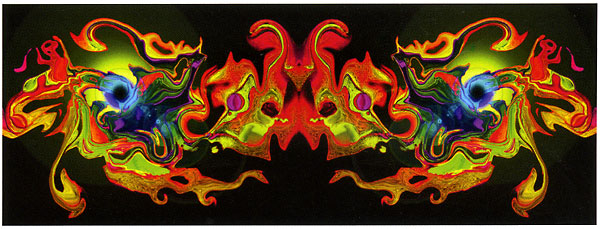
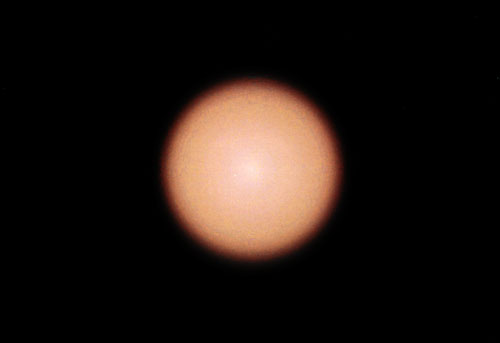
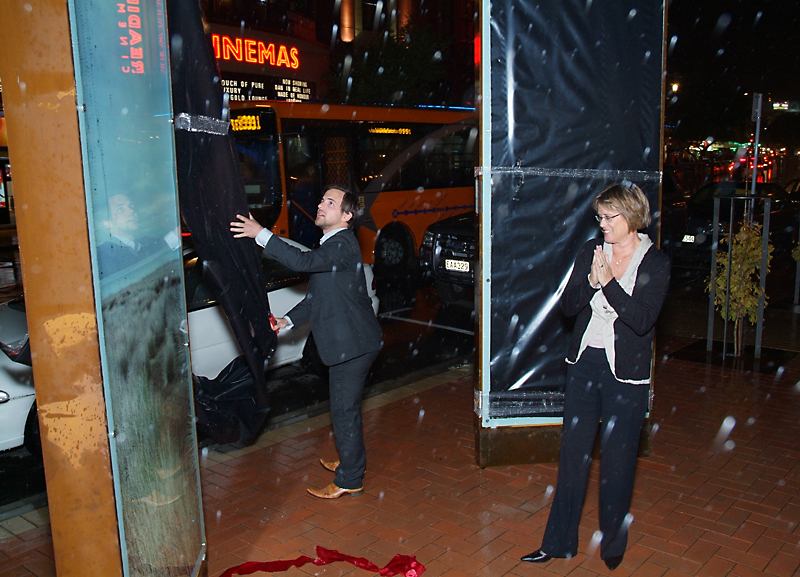
 RSS Feed
RSS Feed
